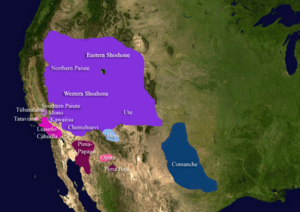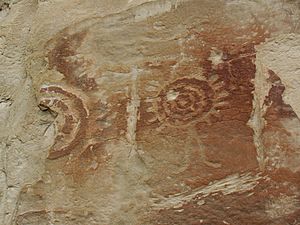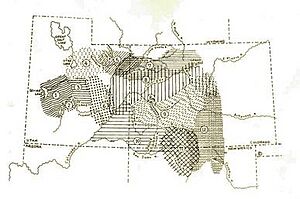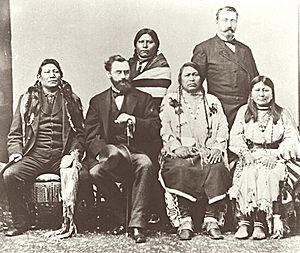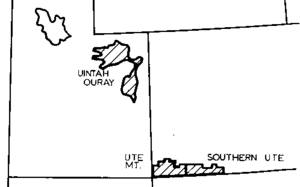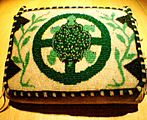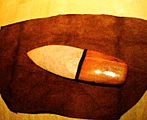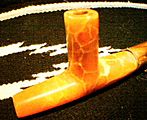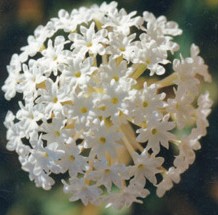Ute people facts for kids
 |
|

Chief Severo and family, c. 1899
|
|
| Total population | |
|---|---|
| 4,800–10,000 | |
| Regions with significant populations | |
| Languages | |
| English, Ute | |
| Religion | |
| Native American Church, traditional tribal religion, and Christianity | |
| Related ethnic groups | |
| Chemehuevi and Southern Paiute people |
The Ute people are an Indigenous group who have lived in what is now Utah and Colorado for many centuries. They were the original inhabitants of these lands. In fact, the state of Utah is named after the Ute tribe!
Their traditional hunting grounds were very large. They stretched into areas that are now Wyoming, Oklahoma, Arizona, and New Mexico. The Ute also had special sacred places they visited at different times of the year.
Historically, there were 12 different groups, or bands, of Utes. While they often lived in small family groups for hunting and gathering, they would come together for important ceremonies and to trade goods. Many Ute bands learned from and traded with other nearby Native American tribes.
When early European settlers, like the Spanish, arrived, the Ute started trading with them. Getting horses from the Spanish completely changed their way of life. Horses made them more mobile, improved their hunting, and changed how their tribes were organized. Before horses, they mainly fought to defend themselves. With horses, they became skilled riders and sometimes raided other tribes. A man's skill with horses and how many horses he owned became very important.
In the mid-1800s, more European settlers and gold miners moved into the Western United States. The Utes faced increasing pressure and violence. They were eventually forced off their traditional lands. They signed agreements, called treaties, with the United States government to try and keep some of their land and protect their people. However, they were later moved to government-created reservations. Some important conflicts during this time include the Walker War (1853), the Black Hawk War (1865–72), and the Meeker Massacre (1879).
Today, most Ute people live in Utah and Colorado. They live on three main Ute tribal reservations:
- The Uintah and Ouray Indian Reservation in northeastern Utah (about 3,500 members).
- The Southern Ute Indian Reservation in Colorado (about 1,500 members).
- The Ute Mountain Ute Tribe reservation, mostly in Colorado but also in Utah and New Mexico (about 2,000 members).
Most Ute people live on these reservations. They have fewer resources compared to their original vast lands. Some Ute people also live off the reservations.
What Does "Ute" Mean?
The exact origin of the word Ute is not known. The Spanish first used the word Yuta in their documents. It was likely a name they created for the native people. The Utes call themselves núuchi-u, which means 'the people'. However, most English and Spanish speakers still use the name Ute.
Ute History and Culture
Ute Language Group
The Ute people speak a language from the Southern Numic branch of the Uto-Aztecan language family. This language family is found mostly in the Western United States and Mexico. The name "Uto-Aztecan" shows that it includes languages from the Colorado River Numic language (Uto) in the U.S. and the Nahuan languages (Aztecan) in Mexico.
It is believed that this Numic language group started near the border of Nevada and California. Then, it spread north and east. By about the year 1000, hunters and gatherers of Uto-Aztecan heritage lived in the Great Basin. These people are thought to be the ancestors of many Indigenous tribes in the Great Basin. This includes the Ute, Shoshone, Hopi, Paiute, and Chemehuevi peoples. Some experts believe the Southern Numic speakers, like the Ute and Southern Paiute people, were the first to leave their original homeland. This is based on how their languages changed.
Ute Traditional Lands and Lifestyle
Where the Ute Lived
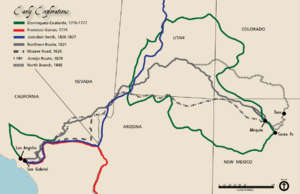
By the year 1300, Ute ancestors lived in southwestern Colorado and southeastern Utah. They lived by hunting and gathering food. By the 1600s, the Ute lived in a large part of what is now Colorado. Other tribes, like the Comanches, Arapaho, and Cheyenne, later moved into eastern Colorado.
The Utes lived in a huge area. This included most of Utah, western and central Colorado, and south into the San Juan River area of New Mexico. Some Ute groups stayed close to their home areas. Others traveled further away during different seasons. Their hunting grounds reached into Wyoming, Oklahoma, Texas, and New Mexico. In winter, they set up camps along rivers near modern cities like Provo, Utah and Fort Duchesne, Utah in Utah, and Pueblo, Colorado, Fort Collins, Colorado, and Colorado Springs, Colorado in Colorado.
Colorado
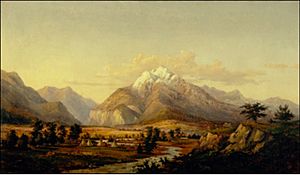
Besides their main home areas, the Ute had sacred places in Colorado. The Tabeguache Ute name for Pikes Peak is Tavakiev, meaning "sun mountain." They spent summers in the Pikes Peak mountains. This area was seen by other tribes as belonging to the Utes. Pikes Peak was a very important ceremonial place for the band. The mineral springs at Manitou Springs were also sacred. Ute and other tribes visited this area. They spent winters there and shared the waters without fighting. Tools found nearby suggest that groups would gather after hunting to prepare animal hides and meat.
The old Ute Pass Trail went east from Monument Creek to Garden of the Gods and Manitou Springs, Colorado. From Ute Pass, Utes traveled east to hunt buffalo. They spent winters in mountain valleys, safe from bad weather. The North and Middle Parks of Colorado were favorite hunting spots because there was a lot of game.
Cañon Pintado, or "painted canyon," is an ancient site with rock art. It has art from the Fremont culture (650 to 1200) and the Utes. The Fremont art shows their interest in farming, with images of corn stalks. The Utes left images of firearms and horses in the 1800s. One image shows a horse with a brand from George Crook's army during the Indian Wars of the 1870s.
Utah
The land around the Bears Ears buttes in southeastern Utah became the Bears Ears National Monument in 2016. This was to honor its importance to several Native American tribes, including the Utes. Members of the Ute Mountain Ute and Uintah and Ouray Reservations are part of a group of five tribes that help manage the monument.
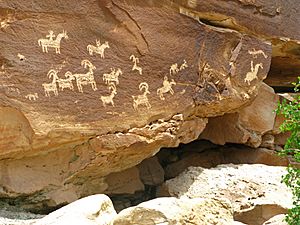
The Ute people hunted and camped at an ancient site near what is now Arches National Park. This site was also used by the earlier Ancestral Puebloans and Fremont culture peoples. At a place near natural springs, which may have been spiritual, the Ute left their own rock carvings. Some of these images are over 900 years old. The Ute carvings show men hunting while riding horses, meaning they were made after the Utes got horses.
Ute Culture and Daily Life
The Ute culture was shaped by nearby Native American tribes. Eastern Utes were similar to Plain Indians. They lived in tepees after the 1600s. Western Utes were more like the Shoshone and Paiute peoples. They lived year-round in round houses made of willow branches. The Weeminuches lived in willow houses during the summer. The Jicarilla Apache and Puebloans influenced the southeastern Utes. All groups also built shelters with conical pole-frames and brush. Sweat lodges were built in a similar way. They also used hide tepees and ramadas, depending on the area.
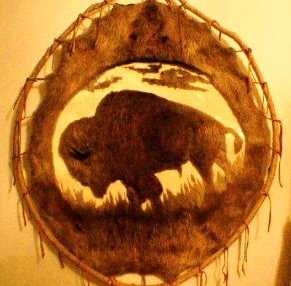
People lived in large family groups of about 20 to 100 individuals. They moved to different camps depending on the season. In spring and summer, families hunted and gathered food. Men hunted animals like buffalo, antelope, elk, deer, bear, rabbit, and beaver using arrows, spears, and nets. They smoked and sun-dried meat, and also ate it fresh. They also fished in fresh water, like Utah Lake. Women prepared and stored the meat. They also gathered plants like greens, berries, roots, pine nuts, and seeds. The Pahvant were the only Utes who grew their own food. Some western groups ate reptiles and lizards. Some southeastern groups planted corn and grew wild tobacco. Tools were made from wood, stone, and bone. They used skin bags and baskets to carry things. There is proof that Utes made pottery as early as the 1500s.
Men and women wore clothes made from woven materials and leather. They also wore robes made from rabbit skins. They wore their hair long or in braids. Parents gave some advice, but people chose their own spouses. Men could have more than one wife. Divorce was common and easy. Children were taught to be hardworking through special rituals. When someone died, they were buried in their best clothes, facing east. Their belongings were usually destroyed, and their horses either had their hair cut or were killed.
Sometimes, members of different Ute bands would meet up to trade, marry each other, and hold ceremonies. A very important one was the annual spring Bear Dance.
Historic Ute Bands
The Ute people were divided into several groups, or bands. These bands were nomadic and closely connected. Today, they are mostly organized into the Northern, Southern, and Ute Mountain Ute Tribes.
By the mid-1600s, hunting and gathering family groups were led by older members. Activities like buffalo hunting and trading might have been organized by band members. Chiefs led bands when more organization was needed, especially after horses arrived. This helped with defense, buffalo hunting, and raiding. By the 1700s, bands started coming together for larger tribal activities.
Several Ute bands were grouped together as "Uintahs" by the U.S. government when they were moved to the Ute Indian Tribe of the Uintah and Ouray Reservation. These bands included the San Pitch, Pahvant, Seuvartis, Timpanogos, and Cumumba Utes. The Southern Ute Tribes include the Muache, Capote, and the Weeminuche.
Relationships with Other Native Nations
The Utes traded with Puebloans from the Rio Grande valley. They met at yearly trade fairs called rescates at places like Taos Pueblo and Santa Clara Pueblo, New Mexico. They traded with the Navajo, Havasupai, and Hopi peoples for woven blankets. The Utes were close friends with the Jicarilla Apache. They shared much of the same land and married into each other's tribes. They also married people from the Paiute, Bannock, and Western Shoshone tribes. There was so much intermarriage with the Paiute that it's hard to tell exactly where Ute and Southern Paiute lands ended in southeast Utah. Before the Ute got horses, fights with other tribes were usually for defense. They generally did not get along well with the Northern and Eastern Shoshone.
Contact with the Spanish
The Utes first met the Spanish before 1620. They might have met as early as 1581. The Spanish knew about the high-quality deerskin the Utes made. The Utes traded with the Spanish in the San Luis Valley starting in the 1670s. They also traded in northern New Mexico in the early 1700s, and in Ute villages in what is now western Colorado and eastern Utah. The Utes were the main trading partners for the Spanish in New Mexico. They were known for their soft, high-quality tanned deer skins, called chamois. They also traded meat, buffalo robes, and captives taken from other tribes. The Utes traded these goods for cloth, blankets, guns, horses, corn, flour, and jewelry. Many Utes learned Spanish through trading. The Spanish carefully controlled trade with the Utes, limiting it to yearly trips. But by 1750, they relied on Ute trade, as deerskin was very popular. The Utes also traded captives, especially women and children, from Apache, Comanche, Paiute, and Navajo tribes.
In 1637, the Spanish fought the Utes. Eighty Utes were captured. Three people escaped with horses. The Ute way of life changed when they got horses by 1680. They could move around more easily, trade more, and hunt large animals better. Ute culture changed a lot, becoming more like the Plains Indians cultures. They also became involved in trading horses and captives, and were respected warriors. Owning horses and being skilled at riding became the most important signs of status in the tribe. Horse racing became common. With more movement, there was a greater need for strong leaders.
During this time, few people entered Ute territory. Some exceptions include the Domínguez–Escalante expedition in 1776. French trappers also passed through or set up trading posts starting in the 1810s. The French recorded meeting members of the Moanunts and Pahvant bands.
Ute Warriors
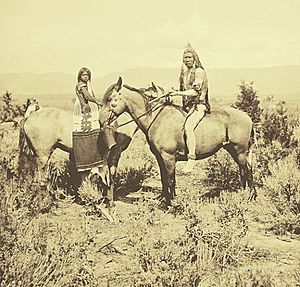
After the Utes got horses, they started to raid other Native American tribes. Their relatives, the Comanche, moved out of the mountains and became Plains Indians. Other tribes like the Cheyenne, Arapaho, and Kiowa also became Plains Indians. But the Utes stayed close to their traditional homeland. The southern and eastern Utes also raided Native Americans in New Mexico, Southern Paiutes, and Western Shoshones. They captured women and children and sold them for Spanish goods. They fought with Plains Indians, including the Comanche, who had been their friends. The name "Comanche" comes from the Ute word kɨmantsi, meaning "enemy." The Pawnee, Osage, and Navajo also became enemies of the Plains Indians around 1840. Some Ute bands fought against the Spanish and Pueblos with the Jicarilla Apache and the Comanche. The Ute were sometimes friendly and sometimes hostile to the Navajo.
The Utes were skilled warriors, especially in fighting on horseback. They fought with neighboring tribes mostly to gain respect, steal horses, and get revenge. Men would form war parties with warriors, medicine men, and a war chief. To get ready for battle, Ute warriors often fasted, took part in sweat lodge ceremonies, and painted their faces and horses with special symbols. The Utes were amazing horse riders. They could do daring moves on horseback during battle. Most Plains Indians had warrior societies, but the Ute generally did not. Southern Utes developed such groups later, but they soon disappeared when they moved to reservations. Only men were warriors, but women often followed war parties. They helped gather stolen goods and sang songs. Women also performed the Lame Dance to show how they had to carry heavy loads after a raid. The Utes used many weapons, including bows, spears, buffalo-skin shields, as well as rifles, shotguns, and pistols they got from raiding or trading.
Contact with Other European Settlers
By the early 1800s, the Ute people traded with Europeans. They met at camps in the San Luis Valley, Wet Mountains, and the Upper Arkansas Valley. They also traded at the yearly Rocky Mountain Rendezvous. Native Americans also traded at annual fairs in New Mexico. These were also ceremonial and social events that lasted for many days. They traded skins, furs, foods, pottery, horses, clothing, and blankets.
In Utah, Utes started to be affected by European-American contact when Mormon settlers arrived in 1847. As the Mormons moved south, they pushed the Utes off their land.
Wars with settlers began around the 1850s. Ute children were captured in New Mexico and Utah by traders and sold in New Mexico and California. Many European-American settlers and gold miners rushed into Ute land after gold was found in 1858. The Ute allied with the United States and Mexico in their war with the Navajo during the same time.
The Mormons continued to pressure the Utah Utes to leave their land. This led to the Walker War (1853–54). By the mid-1870s, the Utes had been moved to a reservation. This was less than 9% of their original land. The Utes found this land very difficult to live on. They tried to keep hunting and gathering off the reservation. Meanwhile, the Black Hawk War (1865–72) happened in Utah.
A reservation was also created in Colorado in 1868. Government agents tried to make the Utes farm. This would be a huge change in their way of life. The Utes believed it would lead to starvation because crops had failed before. Their lands were slowly taken away. Only the modern reservations were left. A large amount of land was given up in 1873, including the gold-rich San Juan area. This was followed in 1879 by the loss of most of their remaining land after the "Meeker Massacre." Utes were later put on a reservation in Utah, the Uintah and Ouray Indian Reservation. They were also moved to two reservations in Colorado, the Ute Mountain Ute Tribe and the Southern Ute Indian Reservation.
Treaties with the United States
After the United States gained Ute territory from Mexico in 1848, the U.S. government made many treaties and orders. These eventually led to the Utes being moved to reservations:
- In 1849, Ute chiefs signed a peace treaty at Abiquiú, New Mexico.
- In 1861, President Abraham Lincoln set aside the Uinta River Valley in Utah for Native Americans.
- In 1863, leaders of the Tabeguache Utes signed a treaty. They gave up all land east of the Continental Divide.
- In 1864, President Lincoln signed a law to move all Native Americans in Utah to the Uinta Valley Reservation.
- In 1868, leaders of the seven Ute bands signed the Ute Treaty of 1868 in Washington, D.C.. The Utes were moved to a reservation in western Colorado and the Uinta Valley Reservation in Utah.
- In 1873, Ute leaders signed the Brunot Treaty. They gave up land in the San Juan Mountains that miners wanted.
- In 1878, leaders of the Capote, Mouache, and Weeminuche Utes signed an agreement. This created the Southern Ute Indian Reservation and gave up all other land in Colorado.
- In 1880, Ute leaders signed the Ute Agreement of 1880. This moved the Tabeguache Utes to the Grand Valley of Colorado. It also moved the Parianuche and Yamparica Utes to the Uintah Reservation in Utah.
- In 1882, President Chester A. Arthur ordered the Tabeguache Utes to move to the new Uncompahgre Indian Reservation in Utah.
- In 1940, the Weeminuche Utes separated from the Southern Ute Indian Reservation. They became the Ute Mountain Tribe.
Ute Reservations Today
Uintah and Ouray Indian Reservation
The Uintah and Ouray Indian Reservation is the second-largest Indian Reservation in the U.S. It covers over 4.5 million acres (18,200 square kilometers) of land. The tribe owns about 1.2 million acres (4,850 square kilometers) of surface land. They also own 40,000 acres (160 square kilometers) of mineral land within the reservation. It was founded in 1861. It is located in several counties in Utah. Raising livestock and leasing land for oil and gas are important ways the reservation earns money.
Northern Ute Tribe
The Ute Indian Tribe of the Uintah and Ouray Reservation (Northern Ute Tribe) includes these groups:
- The Uintah tribe, which is larger than its original historical band. The U.S. government grouped several bands as Uintah when they moved them to the reservation. These included the Sanpits, Pahvant (who did not join the Paiute), Timpanogos, and Seuvarits.
- The White River Utes, made up of the Yampa and Parianuche Utes.
- The Uncompahgre, who were formerly called the Tabeguache Utes.
Southern Ute Indian Reservation
The Southern Ute Indian Reservation is in southwestern Colorado. Its main town is Ignacio, Colorado. The area around the reservation has hills near Bayfield, Colorado and Ignacio.
The Southern Ute are one of the wealthiest Native American tribes. They have financial assets close to $2 billion. They earn money from gambling, tourism, oil and gas, and real estate leases. They also have many financial and business investments outside the reservation. The tribe owns the Red Cedar Gathering Company, which runs natural gas pipelines. They also own the Red Willow Production Company, which explores for oil and natural gas in Colorado, New Mexico, and Texas. The Sky Ute Casino and its entertainment facilities, along with Lake Capote, attract tourists. They host the Four Corners Motorcycle Rally every year. The Ute also run KSUT, a public radio station for southwestern Colorado.
Southern Ute Tribe
The Southern Ute Tribes include the Muache, Capote, and the Weeminuche. The Weeminuche are part of the Ute Mountain reservation.
Ute Mountain Reservation
The Ute Mountain Reservation is near Towaoc, Colorado, in the Four Corners region. The tribe owns 12 ranches through land trusts. They also own over 40,000 acres in Utah and Colorado. The reservation is about 553,000 acres. It borders Mesa Verde National Park, the Navajo Nation, and the Southern Ute Reservation. The Ute Mountain Tribal Park is next to Mesa Verde National Park. It has many ancient Puebloan ruins. Their land includes the sacred Ute Mountain. The White Mesa Community in Utah is part of the Ute Mountain Ute Tribe, but it is mostly independent.
The Ute Mountain Utes are descendants of the Weeminuche band. They moved to the western end of the Southern Ute Reservation in 1897. Their leader was Chief Ignacio, after whom the eastern capital is named.
Changes on the Reservations
Before living on reservations, Utes shared land with other tribal members. This was part of their traditional way of life. The U.S. government did not recognize this. Instead, they gave out individual plots of land, called allotments. Families received more land than single men. The Utes were expected to farm this land, which forced them to change their jobs. Some tribes, like the Uintah and Uncompahgre, received good farming land. But others got land that was not good for farming, and they resisted being forced to farm. The White River Utes were the most upset and protested in Washington, D.C. The Weeminuches successfully kept a shared property system for their allotted land. Utes were forced to do manual labor, give up their horses, and send their children to American Indian boarding schools. Sadly, almost half of the children sent to boarding school in Albuquerque died in the mid-1880s, mostly from diseases like tuberculosis.
The Ute population dropped a lot. This was partly because some Utes moved off the reservation or were not counted. In the early 1800s, there were about 8,000 Utes. By 1920, there were only about 1,800 tribal members. However, in the mid-1900s, the population started to grow again. This is partly because many people have returned to reservations, including those who left for college or careers. By 1990, there were about 7,800 Utes. About 2,800 lived in cities and towns, and 5,000 lived on reservations.
Utes have governed themselves since the Indian Reorganization Act of 1934. They hold elections to choose tribal council members. The Northern, Southern, and Ute Mountain Utes received a total of $31 million in a land claims settlement. The Ute Mountain Tribe used their money, including what they earned from mineral leases, to invest in tourism and other businesses in the 1950s. In 1954, the Ute Partition and Termination Act removed some Ute members from federal recognition. These "mixed-blood" Utes later formed a group to fight for their rights. This act took away their tribal lands, federal benefits, and official tribal status. It caused lasting economic and cultural harm, making life harder and forcing them to adopt American ways.
Since the Indian Self-Determination and Education Assistance Act of 1975, the Utes control their own police, courts, money management, and schools.
Modern Ute Life
All Ute reservations are involved in oil and gas leases. They are members of the Council of Energy Resource Tribes. The Southern Ute Tribe is very successful financially. They have a casino that brings in money. The Ute Mountain Ute Tribe earns money from gas and oil, mineral sales, casinos, raising livestock, and making pottery. The tribes also make some money from tourism and selling timber. Ute artists create beautiful basketry and beadwork.
The average household income on the reservation is lower than for their non-Native neighbors. Unemployment is high on the reservation, often due to discrimination. Half of the tribal members work for the U.S. government or the tribe itself.
The Ute language is still spoken on the reservations. Housing is generally good and modern. The annual Bear and Sun dances are still performed. All tribes have scholarship programs to help members go to college. In 2000, the average life expectancy was 40 years.
Spirituality and Religion
Utes have traditionally believed that all living things have a special power. A medicine person, who can be any gender, receives power from dreams. Some also go on vision quests. In the past, Utes relied on medicine people for their physical and spiritual health. However, this role is becoming less common. New spiritual leaders have appeared who perform ceremonies that medicine people used to do. This includes sweat ceremonies, which are some of the oldest Ute spiritual practices. They are performed in a sweat lodge. The annual Sun Dance is an important traditional spiritual event. It is a time for fasting and purification, a feast, and a way to celebrate their Native American identity. It is held in mid-summer. Each spring, the Ute (Northern and Southern) hold their traditional Bear Dance. This dance helps strengthen social ties and is a way for people to meet partners. It is one of the oldest Ute ceremonies.
The Native American Church is another source of spiritual life for some Ute people. Followers believe that "God reveals Himself in Peyote." The church combines Native American rituals with Christian beliefs. One of its followers was Sapiah ("Buckskin Charley"), a chief of the Southern Ute Tribe.
Some Utes learned about Christianity from Presbyterian and Catholic missionaries. Some Northern Utes accepted Mormonism. It is common for Ute people to see Christianity and Native American spirituality as beliefs that can go together. They don't feel they have to choose one over the other.
Ceremonial Objects
Utes have made beautiful beadwork for centuries. They got glass beads and other items from early trading with Europeans. They quickly started using these in their objects.
Native Americans have used ceremonial pipes for thousands of years. Traditional pipes are used in sacred Ute ceremonies led by a medicine person or spiritual leader. The pipe symbolizes the Ute's connection to the creator and their life on Earth. They hold pipe ceremonies when different people come together. For example, they held a pipe ceremony at an Interfaith event in Salt Lake City.
The Uncompahgre Ute Indians from central Colorado were one of the first groups in the world known to use mechanoluminescence. This is when light is produced by rubbing or hitting certain materials. They used quartz crystals to create light. This was likely hundreds of years before the modern world understood this effect. The Ute made special ceremonial rattles from buffalo rawhide. They filled these rattles with clear quartz crystals from the mountains of Colorado and Utah. When the rattles were shaken at night during ceremonies, the friction of the crystals hitting each other made flashes of light. This light partly shone through the buffalo hide. These rattles were believed to call spirits into Ute ceremonies. They were considered very powerful religious objects.
-
A Northern Ute Beaded Pipebag. This bag has sacred Ute symbols: blue fire, yellow fire, green earth, and hail from thunder beings. It also shows turtles (earth), moccasins (home), red fire, and the bear, which is a sacred animal.
-
An early 1900s Uncompahgre Ute beaded horse bag. It was used to hold sacred items like religious totems, pipes, and carvings. These objects were used in private prayers and family rituals.
-
Uncompahgre Ute Salmon Alabaster Ceremonial Pipe. Ute pipes are thicker and use shorter stems than Plains Indian pipes. They are more like the pipe styles of their northern neighbors, the Shoshone.
Plants and Medicine
Ute medicine women used up to 300 different plants to treat illnesses. Pine pitch or split cactus was used for sores or wounds. Sage leaves were used for colds. Sage tea and powdered obsidian were used for sore eyes. Teas made from various plants treated stomachaches. Grass was used to stop bleeding. The Ute use the roots and flowers of Abronia fragrans for stomach and bowel problems. Cedar and sage were used in purification ceremonies in sweat lodges. Yarrow was also used as medicine by the Utes. Many plants found in Provo Canyon were used by Utes for medicine.
Ute People in Pop Culture
- When the Legends Die (1963) is a book by Hal Borland. It tells the story of a Ute boy who grows up on a reservation and becomes a rodeo star. A movie version was released in 1972.
- The University of Utah's sports teams are called the Utes. The Ute tribe has given them permission to keep using this name.
- In the TV show Resident Alien, the character Asta Twelvetrees (played by Sara Tomko) is a member of the Ute Nation.
- In the movie Cold Pursuit (2019), a gang formed by Utes plays a big role as a rival group to the main bad guys.
Notable Ute People
- Black Hawk: A war leader during the Utah Black Hawk War.
- Chipeta: The wife of Chief Ouray and a Ute representative in talks with the U.S. government.
- R. Carlos Nakai: A famous Native American flutist.
- Ouray: A leader of the Uncompahgre band of the Ute tribe.
- Polk: A Ute-Paiute chief.
- Posey: A Ute-Paiute chief.
- Joseph Rael: (born 1935), a dancer, author, and spiritual leader.
- Sanpitch: A chief of the Sanpete tribe and brother of Chief Walkara. Sanpete County is named after him.
- Raoul Trujillo: A dancer, choreographer, and actor.
- Chief Walkara: Also called Chief Walker. He was the most important chief in the Utah area when the Mormon Pioneers arrived. He was a leader during the Walker War.
See also
 In Spanish: Ute para niños
In Spanish: Ute para niños


